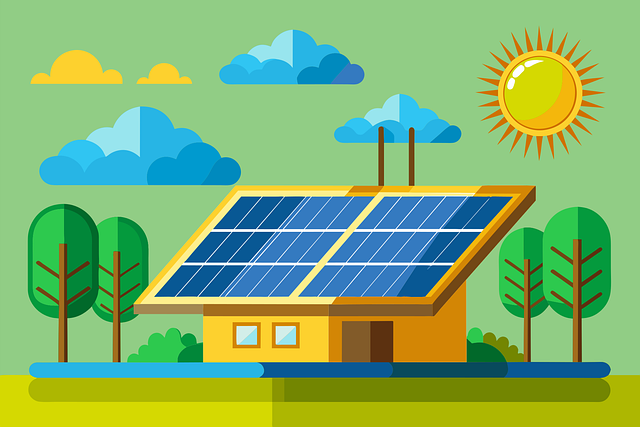“Empowering Tomorrow: Seamlessly Integrating Solar Batteries with Renewable Energy for a Sustainable Future.”
Integrating solar batteries with other renewable energy sources is a pivotal strategy in enhancing the efficiency and reliability of sustainable energy systems. As the demand for clean energy continues to rise, the combination of solar power with energy storage solutions, such as batteries, allows for the optimization of energy generation and consumption. This integration facilitates the smooth management of energy supply, enabling the storage of excess solar energy generated during peak sunlight hours for use during periods of low generation or high demand. Furthermore, coupling solar batteries with other renewable sources, such as wind or hydroelectric power, creates a more resilient and diversified energy portfolio. This synergy not only maximizes the utilization of renewable resources but also contributes to grid stability, reduces reliance on fossil fuels, and supports the transition towards a more sustainable energy future.
Solar Battery Storage and Wind Energy Integration
The integration of solar batteries with wind energy represents a significant advancement in the quest for sustainable energy solutions. As the world increasingly turns to renewable energy sources to combat climate change and reduce reliance on fossil fuels, the synergy between solar and wind power becomes increasingly evident. Both energy sources are abundant and renewable, yet they exhibit complementary characteristics that can enhance overall energy reliability and efficiency. By harnessing the strengths of each, we can create a more resilient energy system.
Solar energy generation is typically highest during the day, while wind energy can be more variable, often peaking during the night or in different seasonal patterns. This inherent difference in generation profiles allows for a more balanced energy supply when both sources are utilized together. When solar batteries are integrated with wind energy systems, they can store excess energy produced during peak solar hours and release it during periods of low generation, such as at night or during calm weather. This capability not only maximizes the use of renewable resources but also stabilizes the energy supply, making it more reliable for consumers.
Moreover, the integration of solar batteries with wind energy can significantly enhance grid resilience. Traditional energy grids often struggle with fluctuations in supply and demand, leading to potential outages or the need for costly peaking power plants that rely on fossil fuels. By incorporating energy storage solutions like solar batteries, the grid can better manage these fluctuations. When wind energy production is high, excess energy can be stored in batteries, which can then be dispatched when demand spikes or when both solar and wind generation are low. This creates a more flexible and responsive energy system that can adapt to changing conditions.
In addition to improving reliability, the combination of solar batteries and wind energy can also lead to economic benefits. As the costs of solar panels and wind turbines continue to decline, the overall investment in renewable energy becomes more attractive. When paired with battery storage, the return on investment can be further enhanced. Homeowners and businesses can reduce their energy bills by utilizing stored energy during peak pricing periods, while utilities can defer investments in new infrastructure by optimizing existing resources. This economic advantage is particularly important as governments and organizations seek to transition to greener energy solutions without imposing excessive costs on consumers.
Furthermore, the environmental benefits of integrating solar batteries with wind energy cannot be overstated. By maximizing the use of renewable resources, we can significantly reduce greenhouse gas emissions and decrease our carbon footprint. This is crucial in the fight against climate change, as the energy sector is one of the largest contributors to global emissions. The more we can rely on clean, renewable energy sources, the closer we move toward a sustainable future.
In conclusion, the integration of solar batteries with wind energy offers a promising pathway toward a more sustainable and resilient energy system. By leveraging the complementary nature of these two renewable sources, we can enhance energy reliability, improve economic viability, and contribute to environmental sustainability. As technology continues to advance and costs decrease, the potential for widespread adoption of this integrated approach becomes increasingly feasible, paving the way for a cleaner, greener energy landscape. The future of energy lies in our ability to harness the power of the sun and wind, and with the right strategies in place, we can create a more sustainable world for generations to come.
Combining Solar Batteries with Hydropower Systems

The integration of solar batteries with hydropower systems represents a significant advancement in the quest for sustainable energy solutions. As the world increasingly turns to renewable energy sources to combat climate change and reduce reliance on fossil fuels, the synergy between solar and hydropower offers a promising pathway to enhance energy efficiency and reliability. By combining these two technologies, we can create a more resilient energy infrastructure that maximizes the strengths of each system while mitigating their individual limitations.
To begin with, solar energy is inherently intermittent, dependent on sunlight availability, which can fluctuate throughout the day and across seasons. In contrast, hydropower provides a more consistent and controllable energy output, as it relies on the flow of water, which can be managed through reservoirs and dam systems. By integrating solar batteries with hydropower, we can effectively store excess solar energy generated during peak sunlight hours. This stored energy can then be utilized during periods of low solar production, such as at night or during cloudy weather, ensuring a continuous and reliable power supply.
Moreover, the combination of these two renewable sources can lead to improved grid stability. When solar energy is abundant, the excess electricity can be directed to charge batteries, which can later discharge energy back into the grid when demand peaks. This not only helps to balance supply and demand but also reduces the need for fossil fuel-based peaker plants, which are often employed to meet sudden spikes in energy consumption. Consequently, the integration of solar batteries with hydropower systems can contribute to a more stable and sustainable energy grid.
In addition to enhancing reliability, this integration can also lead to economic benefits. By utilizing solar batteries in conjunction with hydropower, energy producers can optimize their operations and reduce costs. For instance, during periods of high solar generation, operators can store energy in batteries rather than relying solely on hydropower generation. This approach can help to preserve water resources in reservoirs, allowing for more strategic water management and potentially increasing the lifespan of hydropower facilities. Furthermore, by reducing reliance on traditional energy sources, communities can lower their energy bills and promote local economic development through job creation in the renewable energy sector.
Transitioning to a more integrated energy system also presents challenges that must be addressed. For instance, the technical complexities of managing two different energy sources require advanced control systems and grid management strategies. Additionally, the initial investment in solar batteries and the necessary infrastructure can be significant. However, as technology continues to advance and costs decrease, the feasibility of integrating these systems becomes increasingly viable.
Ultimately, the combination of solar batteries with hydropower systems represents a forward-thinking approach to energy generation and storage. By harnessing the strengths of both technologies, we can create a more resilient and sustainable energy landscape. As we move towards a future dominated by renewable energy, the collaboration between solar and hydropower will play a crucial role in achieving energy independence and environmental sustainability. In conclusion, the integration of these two renewable sources not only enhances energy reliability and economic efficiency but also paves the way for a cleaner, greener future.
The Role of Solar Batteries in Hybrid Renewable Energy Systems
As the world increasingly turns to renewable energy sources to combat climate change and reduce dependence on fossil fuels, the integration of solar batteries into hybrid renewable energy systems has emerged as a pivotal development. Solar batteries play a crucial role in enhancing the efficiency and reliability of these systems, which often combine solar power with other renewable sources such as wind, hydro, and biomass. By storing excess energy generated during peak production times, solar batteries ensure that this energy can be utilized when production is low, thereby smoothing out the intermittent nature of renewable energy generation.
One of the primary advantages of incorporating solar batteries into hybrid systems is their ability to provide energy storage. During sunny days, solar panels can produce more electricity than is immediately needed. Without a storage solution, this excess energy is often wasted. However, when solar batteries are integrated into the system, they capture and store this surplus energy for later use. This capability not only maximizes the utilization of solar energy but also enhances the overall efficiency of the hybrid system. Consequently, energy can be drawn from the batteries during periods of low solar generation, such as at night or during cloudy weather, ensuring a continuous and reliable power supply.
Moreover, the integration of solar batteries with other renewable sources can lead to significant cost savings. For instance, when combined with wind energy, solar batteries can help balance the energy output from both sources. Wind energy production can be highly variable, often peaking at night or during different seasons than solar energy. By storing energy from both sources, solar batteries enable a more stable and predictable energy supply, reducing the need for expensive backup generation from fossil fuels. This not only lowers operational costs but also minimizes greenhouse gas emissions, aligning with global sustainability goals.
In addition to cost efficiency, solar batteries enhance the resilience of hybrid renewable energy systems. In regions prone to power outages or natural disasters, having a reliable energy storage solution can be a game-changer. Solar batteries can provide backup power during outages, ensuring that critical services and homes remain powered. This resilience is particularly important in remote areas where access to traditional power grids may be limited. By integrating solar batteries, communities can achieve greater energy independence and security, reducing their vulnerability to external energy supply disruptions.
Furthermore, the technological advancements in battery storage systems have significantly improved their performance and affordability. Innovations in lithium-ion technology, for example, have led to increased energy density, longer lifespans, and faster charging times. As these technologies continue to evolve, the integration of solar batteries into hybrid systems becomes even more attractive. The decreasing costs of solar batteries also make them more accessible to a broader range of consumers, from residential users to large-scale commercial operations.
In conclusion, the role of solar batteries in hybrid renewable energy systems cannot be overstated. They not only enhance energy storage capabilities but also improve the efficiency, cost-effectiveness, and resilience of these systems. As the demand for clean energy solutions continues to grow, the integration of solar batteries with other renewable sources will play a vital role in shaping a sustainable energy future. By harnessing the full potential of renewable energy through effective storage solutions, we can move closer to achieving a reliable, resilient, and environmentally friendly energy landscape.
Enhancing Energy Resilience: Solar Batteries and Biomass Energy
The integration of solar batteries with biomass energy represents a significant advancement in the quest for sustainable energy solutions. As the world increasingly turns to renewable energy sources to combat climate change and reduce dependence on fossil fuels, the combination of solar power and biomass offers a compelling strategy for enhancing energy resilience. Solar batteries, which store excess energy generated from solar panels, can work in tandem with biomass systems to create a more reliable and efficient energy grid.
To begin with, solar energy is inherently intermittent, with production fluctuating based on weather conditions and time of day. This variability can pose challenges for energy supply, particularly in regions that rely heavily on solar power. By incorporating biomass energy, which can provide a consistent and controllable power output, the overall energy system becomes more stable. Biomass, derived from organic materials such as agricultural waste, wood, and other biological matter, can be converted into electricity or heat, thus serving as a reliable backup when solar generation is low. This complementary relationship ensures that energy demands are met even during periods of low sunlight.
Moreover, the synergy between solar batteries and biomass energy can lead to improved efficiency in energy usage. When solar panels generate excess electricity during peak sunlight hours, this energy can be stored in solar batteries for later use. Instead of relying solely on biomass to meet energy needs during off-peak hours, stored solar energy can be utilized, reducing the amount of biomass required. This not only lowers operational costs but also minimizes the environmental impact associated with biomass production and consumption. By optimizing the use of both energy sources, communities can achieve a more sustainable energy mix.
In addition to enhancing efficiency, the integration of solar batteries with biomass energy systems can also contribute to energy independence. Many regions have abundant biomass resources, which can be locally sourced and converted into energy. By combining this with solar power, communities can reduce their reliance on external energy supplies, thereby increasing their energy security. This localized approach to energy generation fosters resilience, particularly in remote or underserved areas where access to traditional energy infrastructure may be limited.
Furthermore, the environmental benefits of this integration cannot be overlooked. Biomass energy is often considered carbon-neutral, as the carbon dioxide released during combustion is offset by the carbon dioxide absorbed by plants during their growth. When paired with solar energy, which produces no emissions during operation, the overall carbon footprint of the energy system is significantly reduced. This dual approach not only helps mitigate climate change but also promotes sustainable land use practices, as biomass production can encourage responsible agricultural practices and forest management.
As technology continues to advance, the potential for integrating solar batteries with biomass energy will only grow. Innovations in energy storage solutions and biomass conversion technologies are paving the way for more efficient and effective systems. Policymakers and energy planners must recognize the importance of this integration in their strategies for achieving renewable energy targets. By fostering collaboration between solar and biomass sectors, we can create a more resilient and sustainable energy future that meets the needs of both current and future generations.
In conclusion, the integration of solar batteries with biomass energy offers a promising pathway toward enhanced energy resilience. By leveraging the strengths of both renewable sources, we can create a more stable, efficient, and environmentally friendly energy system. As we move forward in our efforts to transition to a sustainable energy landscape, this synergy will play a crucial role in ensuring that our energy needs are met while minimizing our impact on the planet.
Q&A
1. **Question:** What are the benefits of integrating solar batteries with wind energy systems?
**Answer:** Integrating solar batteries with wind energy systems allows for better energy storage, balancing supply and demand, and providing a more reliable power source by compensating for the intermittent nature of both solar and wind energy.
2. **Question:** How do solar batteries enhance the efficiency of a hybrid renewable energy system?
**Answer:** Solar batteries enhance the efficiency of hybrid systems by storing excess energy generated during peak production times and releasing it during low production periods, thus optimizing energy use and reducing reliance on the grid.
3. **Question:** What role do solar batteries play in off-grid renewable energy setups?
**Answer:** In off-grid renewable energy setups, solar batteries store energy generated from solar panels and other sources, ensuring a continuous power supply even when generation is low, thus enabling energy independence and reliability.
4. **Question:** Can solar batteries be integrated with hydroelectric power systems?
**Answer:** Yes, solar batteries can be integrated with hydroelectric power systems to store excess energy produced during high flow periods and release it during low flow periods, improving overall system stability and efficiency.
Conclusion
Integrating solar batteries with other renewable energy sources enhances energy reliability, optimizes resource utilization, and promotes grid stability. This synergy allows for better energy storage, reduces dependence on fossil fuels, and facilitates a smoother transition to a sustainable energy future. By combining solar batteries with wind, hydro, and other renewables, energy systems can achieve greater efficiency, lower costs, and increased resilience against fluctuations in energy supply and demand. Overall, this integration is crucial for maximizing the benefits of renewable energy and achieving long-term sustainability goals.




